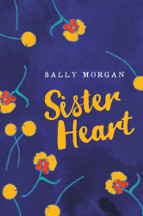Sister heart by Sally Morgan

Fremantle Press, 2015. ISBN 9781925163131
Teachers and librarians know that reluctant and struggling readers
will sometimes be tempted by verse novels which have a rhythm and
structure and typically present more limited text on an open page. I
hasten to emphasise that this verse novel will have a broad, general
readership, however I see it having value in engaging students who
might resist prose.
Anyone who reads this book will be moved to empathise with and
understand the trauma felt by a young Indigenous girl whom we come
to know as Anne, when she is forcibly removed from her family and
community to be transported to a "Government place". The institution
she finds herself in is run more like a prison than a care facility
and appears to exist only to ensure that the children do not have
access to their families before they are deemed old enough to work
for Europeans.
The conditions portrayed are harsh and the treatment by some staff
members is cruel, revealing an attitude that the Aboriginal children
were a problem, were second class and must be detained at the least
cost and with the minimum concern for their welfare.
The notion of "Sisterhood" is a critical element within the
narrative. Anne misses her family desperately and finds solace in
the company of Janey who adopts her much like a sister, immediately
offering advice, friendship and comfort with no expectation of
anything in return. Janey's highly developed sense of responsibility
to ensure the welfare of her own brother Tim, by constantly looking
out for him and lovingly protecting him, underscores her role as a
sister. Nancy, an older girl, soon to be sent to employment, gruffly
guides the younger children in the ways of the facility, much like
an older sister whose mild annoyance with her siblings belies her
love for them. Importantly, Anne also has much to contribute as a
sister as the story develops.
Family and kinship ties are shown to be enormously powerful within
this story and we are shown that despite having wildly different
geographical origins, a common background and a shared need to
survive forges different kinds of sibling relationships.
Dates and specific locations are absent from this narrative and the
real names given to Anne and Janey by their families are never
revealed. The sisterly trust held by Anne and Janey enables them to
eventually share their "secret names" but this is too precious to be
revealed in the text.
All we know is that Anne is forcibly removed and taken by ship to
the "Government place" where the children are known as North
Westerners or South Westerners. The fact that Anne suffers terribly
from the cold implies that she was transported from the North of
Western Australia to the South where Winters would have been much
colder.
Avoiding mentioning particular dates and times appears to me to be
highlighting that this was the common experience for several
generations in many places throughout Australia. However, having
recognised this, I feel that an explanatory foreword may have been
useful for younger readers who might benefit from learning about the
Stolen Generation history.
Rob Welsh